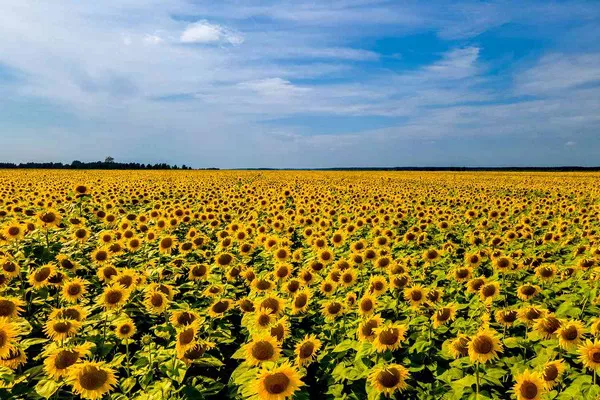Sunflowers, with their vibrant yellow petals and towering stalks, are a quintessential symbol of summer and sunshine. However, as sunflowers bask in the warmth of the sun, they also become a beacon for various insects and bugs. These stunning flowers have a unique relationship with nature, attracting a wide array of insect visitors. In this article, we will delve into the world of sunflowers and explore the bugs that they attract, shedding light on the fascinating interplay between these floral giants and the tiny creatures that visit them.
Sunflowers: Nature’s Allure
Sunflowers (Helianthus annuus) are renowned for their beauty and distinctive features. Their iconic yellow petals radiate positivity, resembling the sun itself, and can grow to impressive heights. These striking flowers often serve as ornamental plants in gardens and are cultivated for their seeds, oil, and various other uses. However, sunflowers are not just a visual delight; they also play a crucial ecological role by providing habitat and nourishment for a diverse range of insects.
1. Bees: Sunflower’s Most Devoted Visitors
Bees are perhaps the most well-known insects associated with sunflowers. Sunflowers produce nectar and pollen, making them a valuable food source for bees. These buzzing insects play a pivotal role in pollinating sunflowers, facilitating their reproduction. Sunflowers’ bright color and unique disc florets make them easily identifiable to bees, who are naturally drawn to their sunny disposition. As bees forage on sunflowers, they transfer pollen from one flower to another, ensuring the plant’s continuation.
2. Butterflies: Dancing in the Sunflower Fields
Butterflies, with their delicate wings and vibrant colors, are another group of insects irresistibly attracted to sunflowers. Sunflowers offer nectar, a primary source of nutrition for butterflies, in their prominent ray florets. These bright, petal-like structures act as landing pads, making it easier for butterflies to access the nectar. Sunflowers’ wide, open faces provide a perfect stage for butterflies to display their graceful flight patterns and vibrant beauty.
3. Ladybugs: Tiny Beneficial Predators
Ladybugs, also known as ladybirds or lady beetles, are frequent visitors to sunflowers. These tiny, round beetles may seem harmless, but they are beneficial predators that feed on aphids, mealybugs, and other garden pests that can harm sunflowers. The presence of ladybugs in sunflower fields can help maintain a healthy balance within the ecosystem, protecting these sunny flowers from potential threats.
4. Ants: Seeking Nectar and Aphids
Ants, though not as charming as butterflies or bees, play a role in sunflower ecosystems as well. They are often found on sunflower plants, attracted by the sweet nectar produced by the flowers. While some ants are benign, others have a more complex relationship with sunflowers. Certain ant species protect aphids that feed on sunflower sap. In return, the ants receive a sugary substance called honeydew excreted by the aphids. This interaction highlights the intricate web of relationships that can exist in sunflower habitats.
5. Grasshoppers and Crickets: Munching on Sunflower Leaves
Sunflower leaves, though not as enticing as the nectar-rich blossoms, are not immune to insect visitors. Grasshoppers and crickets are known for nibbling on the leaves of sunflowers, sometimes causing damage to the plant. Their presence can be a challenge for sunflower growers, as these insects have a voracious appetite for green foliage. Protecting sunflowers from these leaf-munching intruders may require careful management and pest control measures.
6. Birds: Sunflower Seeds as a Tasty Treat
While not insects, birds are attracted to sunflowers for a different reason: their seeds. Sunflower seeds are a valuable source of food for many bird species. These birds, such as finches and sparrows, cling to the tall sunflower stalks, using their sharp beaks to extract seeds from the flower heads. Sunflower fields can become bustling hubs of avian activity, providing a critical food source, especially during the colder months when other food options may be scarce.
7. Bees, Beetles, and More: Pollination Partners
Apart from bees, sunflowers also attract a variety of other pollinators, including solitary bees and beetles. These insects inadvertently aid in the cross-pollination of sunflowers as they collect nectar and pollen for their own survival. The intricate reproductive mechanisms of sunflowers ensure that a wide range of insect visitors contribute to their successful pollination, resulting in the production of seeds for future generations of these iconic plants.
Managing Pest Insects in Sunflower Fields
While sunflowers benefit from the presence of pollinators, some insects can pose challenges to sunflower cultivation. Aphids, for instance, can be detrimental to sunflowers by sucking sap from the plant and transmitting diseases. Sunflower growers often employ integrated pest management (IPM) strategies to mitigate the impact of these pests, which may involve natural predators like ladybugs, as well as organic and chemical treatments when necessary. IPM seeks to strike a balance between protecting the sunflowers and preserving the ecosystem’s overall health.
Conclusion
In conclusion, sunflowers are not only a feast for the eyes but also a magnet for a diverse array of insect visitors. Bees, butterflies, ladybugs, ants, grasshoppers, crickets, and birds all play a role in the intricate tapestry of life that sunflowers support. These interactions highlight the interconnectedness of the natural world and the vital role that sunflowers play in providing food, shelter, and sustenance for many creatures. Understanding the bugs that sunflowers attract allows us to appreciate the beauty and complexity of these sunny flowers on a whole new level, emphasizing their importance in the grand scheme of biodiversity.


